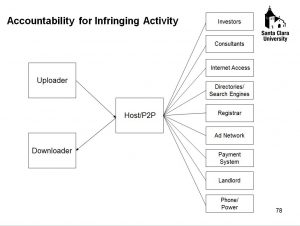IAP Defeats Vicarious Copyright Infringement Claim–UMG v. Bright House

The court says that the legal standard for direct financial interest can’t be whether infringing works were “a draw” for consumers, because that reads the word “direct” out of the test, which allows “the imposition of vicarious liability based on indirect, highly attenuated connections between infringing conduct of the patron and alleged financial benefits.” Instead, the court requires that “availability of infringing material be the primary customer draw to the service” (emphasis added). The plaintiffs didn’t clear this standard:
At most, Plaintiffs allege that access to infringing content generally available on the internet is one of many reasons motivating some subscribers to enroll with any ISP. Plaintiff do not allege that there is anything unique about the service Bright House offers as a portal to the internet or as a portal to this alleged contraband content. Plaintiffs, moreover, do not allege that there is any infringing content “available” on the Bright House platform, such as a storage vehicle (i.e., Cloud storage) from which a would-be infringer could seek to secure infringing content directly or indirectly from Bright House…
Plaintiffs allege is that Bright House’s internet speed and efficiency are “draws” to the service…this allegation does not support a reasonable inference or plausibly assert that the main draw for Bright House subscribers is access to infringing content generally available on the internet. In fact, Plaintiffs do not even adequately assert that efficiency, which allegedly enhances the ease with which an infringer might illegally access copyrighted content, is itself the main draw to Bright House’s service. Instead, Plaintiff advance a sort of “dog-whistle” theory that Bright House advertises faster internet speeds to surreptitiously entice the prospective infringer. It is not readily apparent or plausibly alleged that an internet thief would be “drawn” by the efficiency of internet service any more than the average law-abiding purchaser of copyrighted content. All users presumably seek faster, more reliable internet service.
To get around this, the plaintiffs allege that infringers are drawn to Bright House due to its lax repeat termination policy. The court rejects this argument too: “the test is whether users are drawn to Bright House by the availability of infringing content.”
The plaintiff invoked the DMCA safe harbor’s terms to define the scope of vicarious liability. The court swats that down, saying it’s a safe harbor, not the basis of a cause of action (citing 512(l)–a lightly cited provision–and the DMCA’s Senate Report).
The court summarizes its conclusion:
Under Plaintiffs’ theory, any aspect of Bright House’s service that serves as “a” draw to some subset of subscribers who then go on to engage in infringement subjects Bright House to liability, no matter how insignificant or tangential the alleged draw is to the infringing content wherever found on the internet. Any proportionate value that may be ascribed by post hoc edict to that general enticement to purchase internet services from Bright House cannot constitute a direct financial benefit to Bright House owing principally to the draw to available infringing content.
I believe most of the cited facts would apply equally to other IAPs. If other courts agree with this approach, this ruling will make it virtually impossible to hold IAPs vicariously liable for users’ copyright infringement.
More generally, this ruling and ALS Scan v. Steadfast offer important counternarratives to the jurisprudence holding IAPs liable for subscriber-caused copyright infringement. This ruling hacks away at vicarious copyright infringement; Steadfast hacks away at contributory infringement. Unfortunately, I can’t tell yet if this decision and Steadfast are a turning point in the case law, or if they will eventually be viewed as outliers in the never-ending quest to make IAPs the financial guarantors against their subscribers’ infringements. Of course, the inevitable appeal in this case may shine some light on that question.
Case citation: UMG Recordings, Inc. v. Bright House Networks LLC, 2020 WL 3957675 (M.D. Fla. July 8, 2020)
Pingback: News of the Week; August 5, 2020 – Communications Law at Allard Hall()